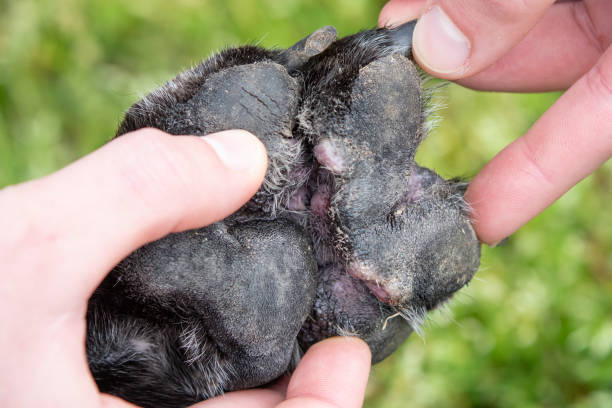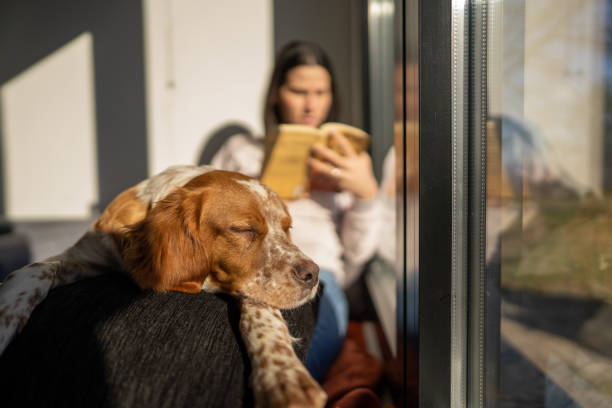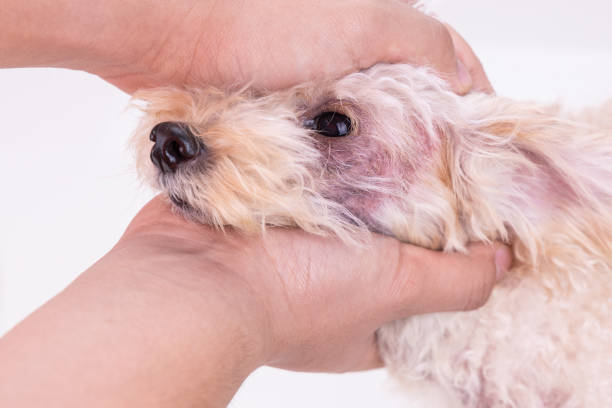If your dog starts limping, seems lethargic, or refuses to put weight on its paw, it’s important to assess the situation. Swollen paws are often experienced by dogs, and this may be due to a range of causes, including injury, arthritis, or too much standing.
Related read: The Best Orthopedic Dog Beds – Top Reviews
This article will tell you how to identify if your dog’s swollen paw is something serious and what the best course of action to take would be. You’ll also find out which cases require urgent veterinary attention.
Identify if Dog Has Swollen Paw
- If the centre of the pad is extremely sensitive and tender or if it’s flat with no support for his weight, he might have a misaligned toe or a bone chip in the centre of his paw pad.
- If there is a fever, he might have a bacterial infection. There’s also a chance that an injury has occurred, causing some serious inflammation around the area. This will be especially painful for your dog, and you need to get him treated as soon as possible.
- If their paw turns a different colour, some tissue or nerve damage might occur. You’ll need treatment immediately in this case because if the tissues are damaged, it means that infection can spread quickly through his body.


Steps to Take
Check the Paw
Take a careful look at your dog’s paw. If it is larger than average, swollen, red or tender to touch, you should seek veterinary attention as soon as possible. This could be an indicator of infection, arthritis or some other serious condition that needs immediate treatment.
Elevate the Paw
If your dog is having difficulty putting weight on their swollen paw, elevate it above the level of their heart. Try a few pillows under their neck and shoulders or a folded blanket under the belly. This will help keep excess swelling down and offer your pet some relief while you figure out what to do next.
Wrap the Paw
If your dog’s paw is swollen, you should avoid the temptation to “wait and see”. That doesn’t mean, of course, that you can grab a tourniquet and start squeezing! You need to apply a nice snug wrap around their ankle. This will help with swelling and support the leg at the same time.
When wrapping your dog’s paw, ensure you wrap snugly-but not too tight, or you’ll cut off circulation! You don’t want to squeeze their paw; provide gentle support.


Reduce Swelling
If the problem is with your dog’s footpad, you can apply ice to help reduce swelling. Place some ice in a bag and wrap it in a towel, then directly apply to the pad of your pet’s foot. Do this for about five minutes, and make sure you give your dog a break between applications. This will help them cope with any pain as well as reduce swelling.
Take Your Dog to the Vet
When in doubt, always take your dog to the vet if their swollen paw seems serious! It’s better to be safe than sorry, especially concerning our pets.
Take a look at the paw pad every day and watch for any changes that worry you. This is probably the biggest mistake people make when it comes to helping a dog with a swollen paw-they think if they give them a little time, everything will go back to normal.
There are many possible causes for a dog’s swollen paw, both serious and not so serious. Most of these problems can be cleared up on your own at home-just try to keep an eye on the affected area and seek veterinary help if you notice any changes.
Seek medical assistance immediately if:
- Your dog’s swollen paw is red, hot, or has a foul smell to it.
- If your pet won’t put weight on their foot due to pain.
- There’s pus, drainage or blackening around the swollen area- a sign of infection that needs to be treated as soon as possible.
Seek medical attention ASAP if:
- Your dog has trouble breathing, is coughing or seems unusually lethargic.
- If your pet’s swollen paw is accompanied by fever and weakness, they could have an underlying illness that needs immediate care.
- Your dog has a history of kidney, liver or heart disease and is showing signs of illness!


What NOT to Do
- Don’t use any tourniquet or apply ice directly to the paw itself if you are unsure what is wrong with your pet. For example, if their paw is broken, this could cause them serious injury!
- Don’t give your dog pain medication without talking to your vet first. Painkillers are designed to take care of specific types of pain that are associated with specific medical conditions. This means that just taking a human aspirin and giving it to your dog will most likely do more harm than good.
- Don’t assume your pet’s swollen paw will get better by itself if it seems painful or serious-if, you are uncertain about what is wrong, it is always best to seek veterinary help.
When should I worry about my dog’s paw being swollen?
If the paw is swollen but doesn’t seem to bother your dog, then you can wait it out. If your dog seems bothered by their paw, or it’s constantly making them walk funny/limping around, then you’ll want to go to the vet.
What are the possible causes for my dog’s swollen paw?
A dog’s paw can become swollen for many different reasons, but the most common is because they have been on it for too long. However, there are several other reasons as well:
- Accumulation of fluid in the paws (oedema) caused by heart failure
- Infection or inflammation accompanied by thickening and bruising (cellular oedema) due to bacterial, viral, and/or fungal infection
- Parasite infestation
- Autoimmune disorder
- Skin irritation from contacts with chemicals like tar or sap
- Allergic reaction involving hypersensitivity to pollen or food allergies that cause hives and soreness around the mouth
- Lack of vitamin C can lead to Reynaud’s syndromes which causes frostbite-like conditions in the digits.
- Damage to the paw pads by any means, such as burns or rashes covering a large area.
- Regularly walking on abrasive terrains.


Treatment for Swollen Paws
It would be best if you always take your dog to the vet immediately. Once you have him checked out, you can treat his swollen paw at home with simple over-the-counter medications. These include:
- An anti-inflammatory such as ibuprofen (you must check with your vet first before giving this medication, though),
- A warm compress for about 10 minutes 3 times a day
- Keeping the area clean and dry
Be safe in giving your dog medicine: Is it Safe to Give a Dog Human Medications?
If something like a bacterial infection happens, you’ll need to ensure your dog gets antibiotics. You should also take them back if things aren’t getting better after a few days or if the pain seems to increase. If their paw starts turning dark from lack of blood flow, you must take your dog to the vet immediately.
Prevention of Swollen Paws
- It would help if you continually keep your dog on a leash whenever they’re out and about across different types of terrain. This is just a good safety measure for them and others who might be nearby. For example, you want to keep them from getting cut by sharp objects.
- When you’re walking on new terrain or concrete, your dog might get a little sore. It would help avoid the concrete at all costs and opt for the grass or a softer surface instead.
- When you let your dog walk around on its own, don’t let it happen for too long. Dogs can’t tell you when they’re in pain or when their paws are sore, so it’s up to you to ensure that doesn’t happen.
- Make sure your dog has enough time to rest after being on its feet all day. They might need a few minutes of lying down, but rest is the best thing for them overall if they’re in pain.
- If they’re going to be on their feet all day and you can’t get home to give them a break, try taking some doggie boots with you when you go out so that your tired pup doesn’t have to walk around on concrete. This will add more cushioning to the soles of their feet and make them a little more comfortable on your walk.


Aftercare for Swollen Paws
- After you take them to see their vet, you should always follow whatever instructions they give you as far as aftercare goes. They might need to bandage up their paw or keep it wrapped with a damp washcloth to help bring down some of the swellings.
- It would be best to keep them from going on too many walks after they get their swollen paw treated for a little while. This is especially true if your dog had surgery on it or if he has an open wound where stitches were placed. You should give him as much time off as the vet recommends in those cases. If they have some minor swollenness that needs to go down, you can probably let them run around outside after a few days.
- Make sure you clean their paws every day with moistened wipes or dog shampoo and gently scrub away any dirt or debris under each toe while you do it.
- Also, be aware that your dog might need some pain medication. If he’s having a hard time walking or if the swelling seems to get worse over a day, you might need to ask for it from your vet.
- Don’t give them things like anti-inflammatory drugs on your own without talking to their doctor first unless you know that’s the only way they can get relief from pain.
- Be sure to keep their paw clean and dry until it heals. If you need a little help, look at this article on caring for your pet while they have a cast. It will give you plenty of information about what to expect when your dog comes home with an injured paw.
- Try to get them used to their new cast or bandage daily by giving them treats when they walk on it. After a little while, you can take it off, give your dog some water and food outside, and then put the cast back on until the next time you take it off later that night. This is just an excellent way to let them adjust a little bit at a time.
- Even if your dog seems like he’s doing ok, you should always continue to give him walks and water outside while he has his cast or bandage on. If the swelling doesn’t go down or if it gets worse even after a few days, you should take them back to the vet for some more treatment.
- If your dog’s paw is swollen, it might take them a little while to walk with it properly. Don’t be afraid to gently massage their paw or ankle area once you get home from taking them to the vet so that they can relax and start walking normally again.
- Remember that every dog is different; what works for one might not be best for another. If your dog doesn’t seem to want to eat or drink anything, no matter how hard you try, you should take them back to the vet so they can fix it. It’s always better to err on the side of caution- especially if they’re having difficulty walking.
- If you’re worried about how your pup is doing, try calling their vet to see if they have any advice. They might be able to walk you through what to do at home or tell you whether you should bring your dog in for an extra visit.
Conclusion
We hope that this article has helped you better identify what to do if your dog’s paw is swollen. It can be challenging to know how to take care of them, but hopefully, we’ve given you some helpful suggestions on how to provide them with a break and keep their paws clean so they don’t get too uncomfortable or develop an infection.


